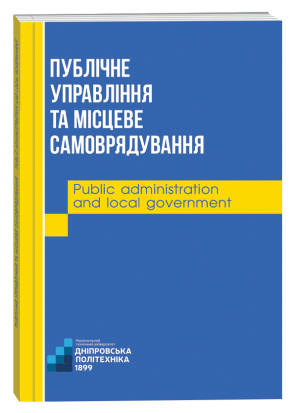MODELLING THE PROCESSES OF IMPROVING THE INSTITUTIONAL SUPPORT FOR THE FORMATION AND IMPLEMENTATION OF THE STATE YOUTH POLICY
DOI:
https://doi.org/10.32782/2414-4436/2023-3-8Keywords:
public administration, state youth policy, institutional support, European experience, interagency and intersectoral interaction, territorial community, conceptual modelAbstract
The article is devoted to the development and scientific substantiation of the components of the conceptual model of institutional support for the formation and implementation of the State youth policy. It is shown that young people are the most dynamic, mobile and promising segment of the population. It is young people who shape the future of the nation, and they have always been and remain in the focus of attention of public authorities, local self-government bodies, and civil society. The increased attention to youth in public administration is transformed into comprehensive and targeted actions to support youth development and make a positive contribution to society, which is possible on the basis of the formation and implementation of an effective state youth policy. The features and priorities for the implementation of youth policy in territorial communities are identified, in particular: creating an appropriate organisational and functional environment for local self-government bodies; harmonising normative, organisational, programme and target and other documents regulating the activities of local self-government bodies with similar higher-level documents; improving the effectiveness of information support for the implementation of youth policy through the promotion of the results of youth programmes and projects. It is shown that interagency and intersectoral cooperation between different ministries in the context of the development of institutional support for the formation and implementation of state youth policy remains an important factor for coordinated actions to achieve the expected results in the shortest possible time. The directions and content of interagency cooperation in the implementation of youth policy by central executive authorities are determined. The article builds a conceptual model of institutional support for the formation and implementation of the State youth policy, which presents its main systemic components (components) and justifies the expediency of their inclusion in the context. This model is descriptive in nature and is based on the legal, intellectual, creative, communicative, strategic and other aspects of the formation and implementation of the State youth policy, on the understanding of the needs, values and interests of young people, as well as on the ability to implement innovative, flexible and adaptive approaches to involve young people in socio-political processes.
References
Біла Д. О. Визначення ролі молоді у суспільстві в умовах політичної невизначеності та особливості формування державної молодіжної політики. Дніпровський науковий часопис публічного управління, психології, права. 2021. № 3. С. 4–70. https://chasopys-ppp.dp.ua/index.php/chasopys/article/view/83/77.
Recommendation CM/Rec (2015)3 of the Committee of Ministers on access of youngpeople from disadvantaged neighbourhoods to social rights. Council of Europe. 2015. 30 р. URL: https://rm.coe.int/168066671e.
Рекомендація CM/Rec(2017)4 Комітету міністрів Ради Європи державам членам про молодіжну роботу: ухвалена Комітетом Міністрів на 1282-му засіданні заступників міністрів 22 березня 2017 року. Страсбург, Рада Європи. 2017. 37 с. URL: https://rm.coe.int/recommendation-cmrec-2017-4-ukr/16808e4d93.
Європейська хартія місцевого самоврядування. Рада Європи: Хартія, Міжнародний документ від 15.10.1985. URL: http://zakon4.rada.gov.ua/laws/show/994_036.
Переглянута Європейська хартія про участь молоді в місцевому та регіональному житті. Council of Europe, July 2015. Printed at the Council of Europe. С. 37. URL: https://is.gd/Wa5x7u.






